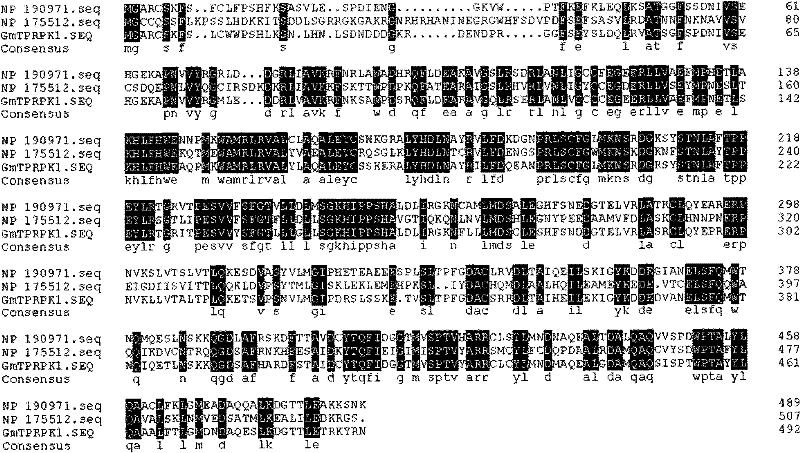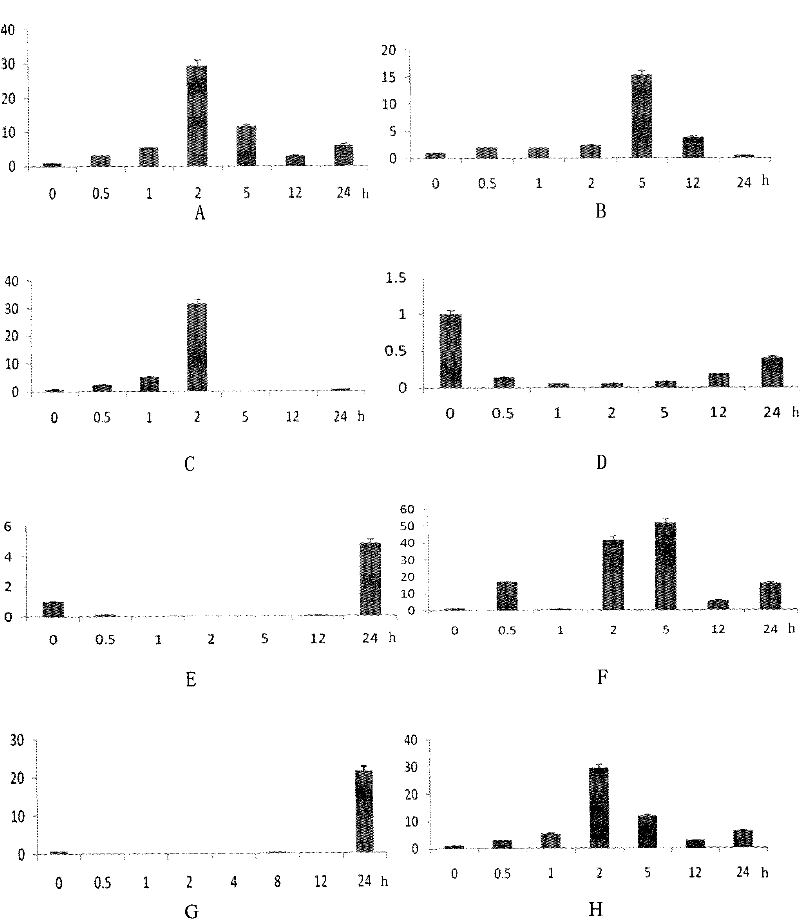Plant stress tolerance related protein GmTPRPK1, encoding gene thereof, and application thereof
A stress tolerance, gene technology, applied in the direction of plant genetic improvement, botanical equipment and methods, application, etc., can solve problems such as comprehensive improvement of stress resistance of difficult plants
- Summary
- Abstract
- Description
- Claims
- Application Information
AI Technical Summary
Problems solved by technology
Method used
Image
Examples
Embodiment 1
[0047] Cloning of embodiment 1, GmTPRPK1
[0048] 1. Isolation of mRNA
[0049] Seedlings of the soybean variety Tiefeng No. 8 (purchased from the Institute of Crop Science, Chinese Academy of Agricultural Sciences) grown in soil pots for about 20 days were quick-frozen in liquid nitrogen and stored at -80°C for later use.
[0050] Total RNA was extracted from soybean leaves by Trizol method (TianGen), and reverse transcriptase XL (AMV) was used for first-strand cDNA synthesis. The ds cDNA was synthesized by SMART method, and the PCR product was detected by 1.0% agarose gel electrophoresis.
[0051] 2. Acquisition of the full-length sequence of the GmTPRPK1 gene
[0052] The full-length sequence of the soybean dual-specificity protein kinase gene was obtained by 5'RACE and 3'RACE methods.
[0053] The protein shown in Sequence 1 of the sequence listing is named GmTPRPK1 protein, which consists of 492 amino acid residues and has a conserved dual-specificity protein kinase ac...
Embodiment 2
[0054] Example 2, real-time fluorescent quantitative PCR analysis of the expression characteristics of GmTPRPK1
[0055] 1. Coercion treatment
[0056] Seedling age is 20 days soybean variety Tiefeng No. 8 seedlings, carry out following treatment:
[0057] (1) Drought treatment ( figure 2 A): The potted soybean seedlings are taken out to absorb the moisture on the roots, placed on dry filter paper, and cultivated in a drought for 30 minutes, 1 hour, 2 hours, 5 hours, 12 hours, and 24 hours. After that, the materials are taken out and quickly frozen with liquid nitrogen. Store at -80°C for later use.
[0058] (2) Salt treatment ( figure 2 B): Soybean seedlings were placed in 200 mM NaCl solution, light cultured for 30 minutes, 1 hour, 2 hours, 5 hours, 12 hours, and 24 hours, and then the materials were taken out, quick-frozen with liquid nitrogen, and stored at -80°C for later use.
[0059] (3) Abscisic acid treatment ( figure 2 C): Soybean seedlings were placed in 200...
Embodiment 3
[0077] Example 3, GmTPRPK1 improves the drought tolerance of Arabidopsis
[0078] 1. Construction of recombinant expression vector
[0079] 1. Cloning of GmTPRPK1 gene
[0080] A pair of primers (GmTPRPK1-121F and GmTPRPK1-121R) were designed according to the sequence of the GmTPRPK1 gene, and SmalI and SpeI recognition sites were introduced at the ends of the primers respectively, and GmTPRPK1 was amplified by PCR using Tiefeng 8 soybean cDNA as a template.
[0081] GmTPRPK1-121F: 5'-TCCCGGGCGTGTGATTGCACTTCTCACCAATG-3';
[0082] GmTPRPK1-121R: 5'-TACTAGTCAATGAGGGGAAGTAGAAG-3'.
[0083] The PCR amplified product was subjected to 1.2% agarose gel electrophoresis, and a band of about 1.5 Kb was recovered and purified using Agarose Gel DNA Purification Kit Ver.2.0 (TaKaRa Company, Code No.: DV807A).
[0084] 2. Construction of recombinant expression vector
[0085] ①Use restriction endonucleases SmalI and SpeI to digest step 1 to recover the purified PCR product, and recover ...
PUM
 Login to View More
Login to View More Abstract
Description
Claims
Application Information
 Login to View More
Login to View More - R&D
- Intellectual Property
- Life Sciences
- Materials
- Tech Scout
- Unparalleled Data Quality
- Higher Quality Content
- 60% Fewer Hallucinations
Browse by: Latest US Patents, China's latest patents, Technical Efficacy Thesaurus, Application Domain, Technology Topic, Popular Technical Reports.
© 2025 PatSnap. All rights reserved.Legal|Privacy policy|Modern Slavery Act Transparency Statement|Sitemap|About US| Contact US: help@patsnap.com



